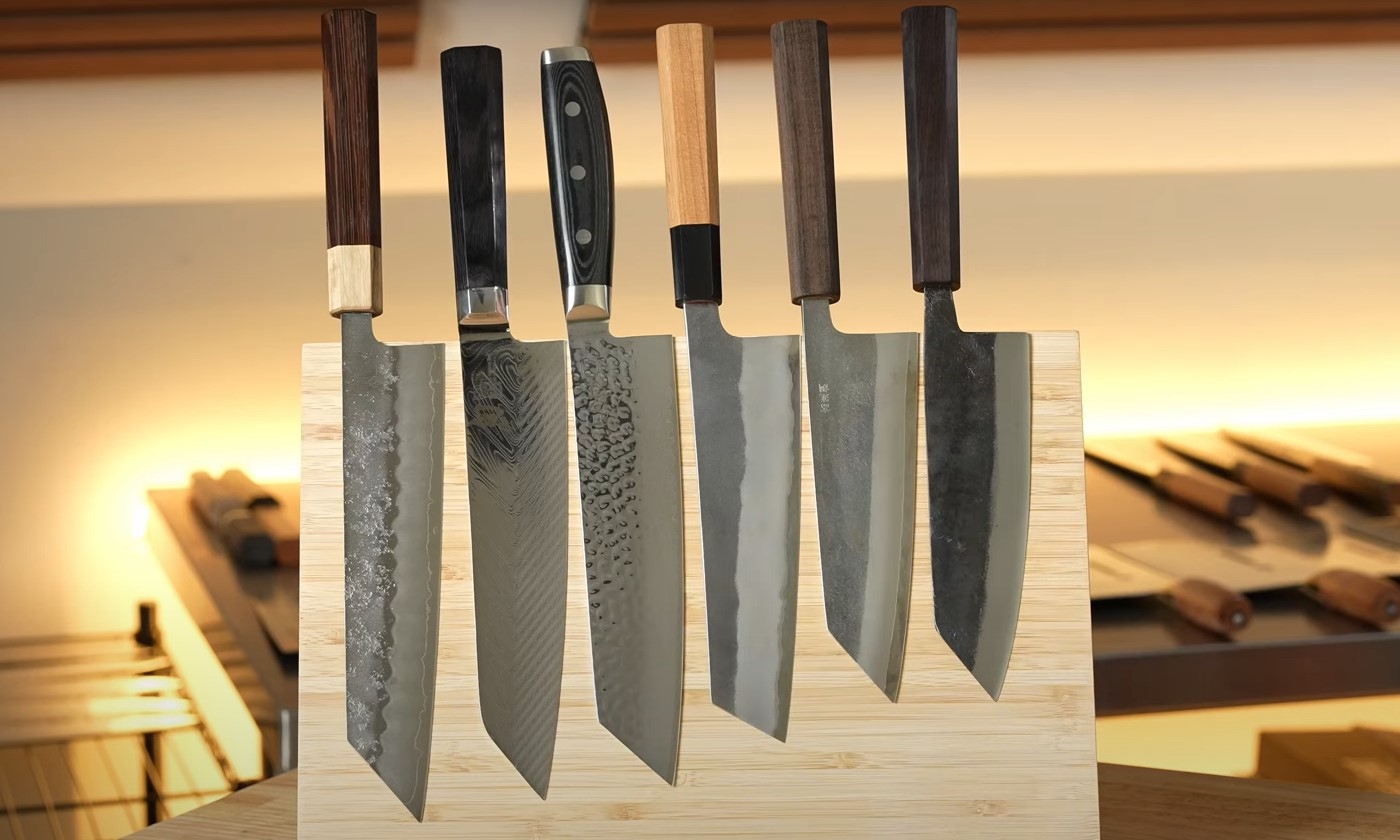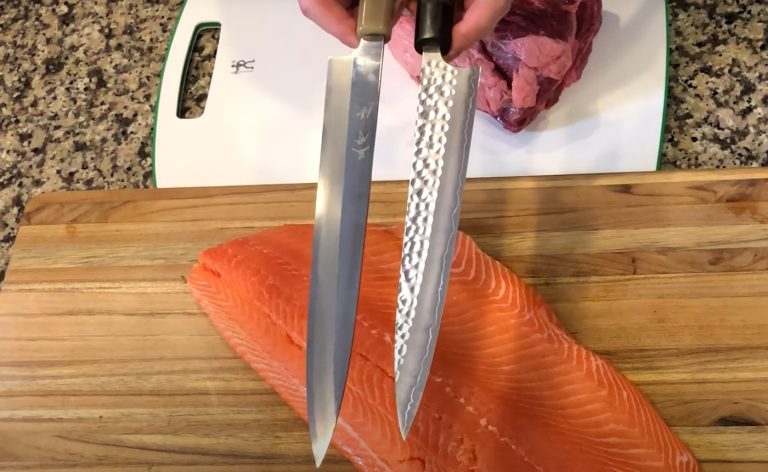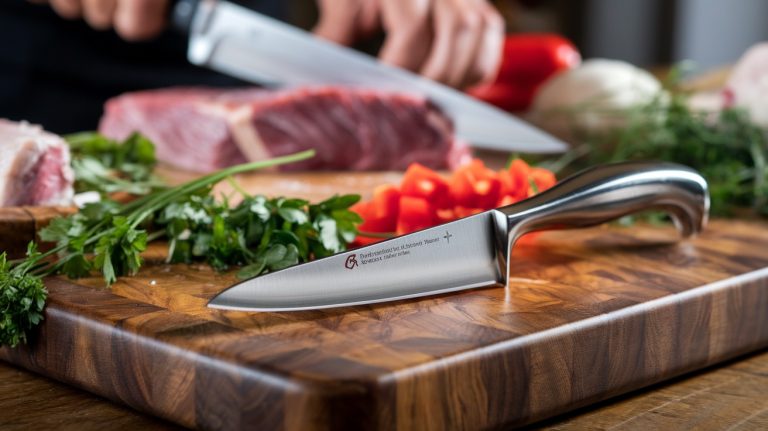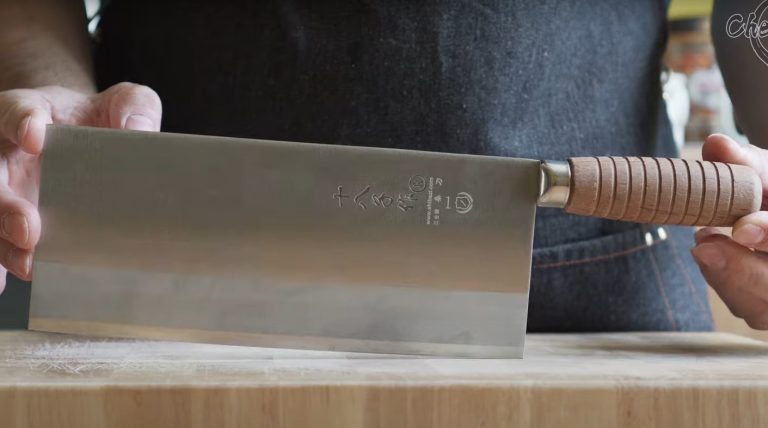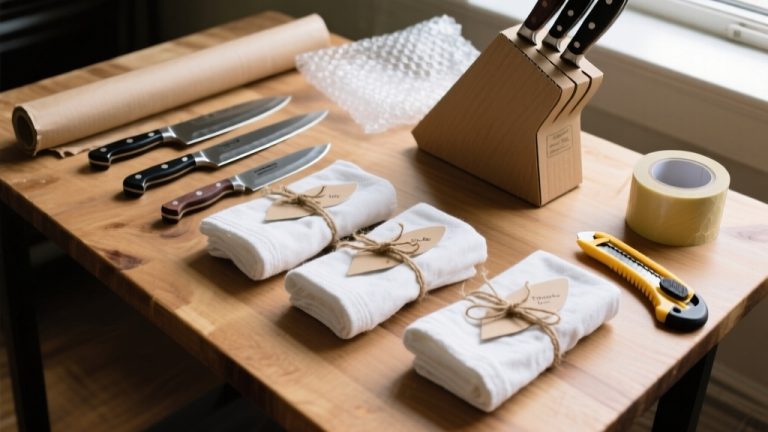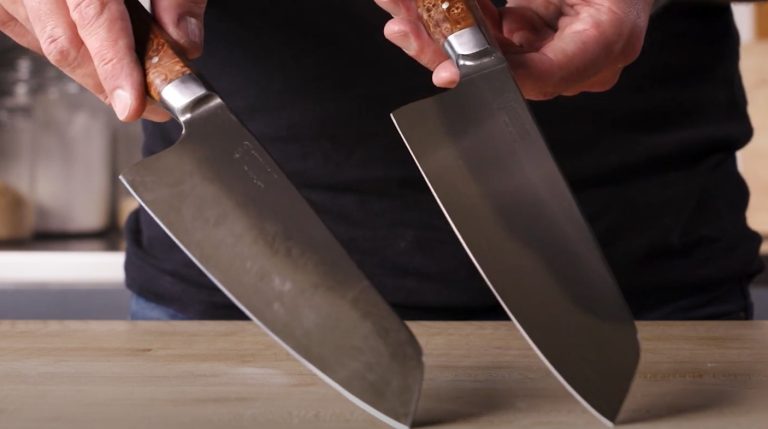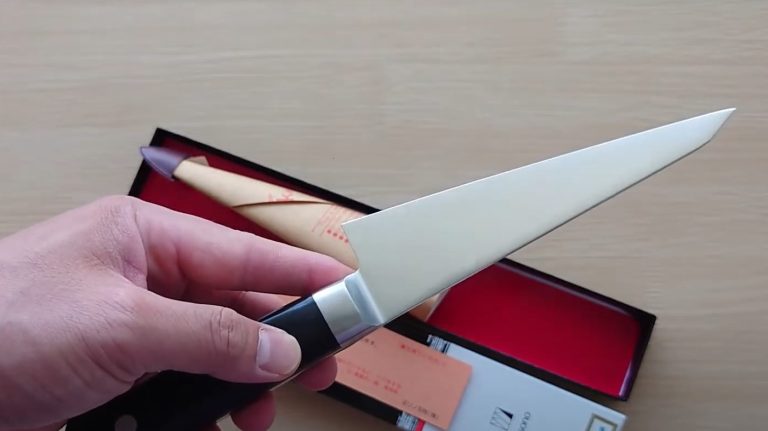Kiritsuke vs Bunka: Which Knife Belongs in Your Kitchen?
When choosing between a Kiritsuke and a Bunka knife, you’re picking between precision and versatility. The Kiritsuke’s long, slender blade, inspired by samurai craftsmanship, excels in masterful slicing of proteins and intricate cuts.
Meanwhile, the compact Bunka, with its triangular tip, handles everyday tasks like veggie prep with ease.
The Kiritsuke suits skilled chefs, while the Bunka’s forgiving design fits beginners. Stick around to uncover deeper insights into these culinary tools.
Key Takeaways
- Kiritsuke has a long, slender blade (210-270mm) with a single-bevel edge, while Bunka is shorter (165-180mm) with a double-bevel design.
- Kiritsuke excels in precise push and pull cuts, ideal for proteins, whereas Bunka supports versatile rock-chopping for vegetables.
- Bunka is beginner-friendly due to its compact size and control, while Kiritsuke suits skilled chefs for precision tasks.
- Kiritsuke’s flatter edge and reverse tanto tip enhance intricate cuts, unlike Bunka’s curved blade for varied tasks.
- Both knives offer unique versatility, with Kiritsuke for presentation cuts and Bunka for detail work like mincing.
Historical Roots and Evolution
As you explore the world of Japanese culinary tools, you’ll discover that Kiritsuke and Bunka knives carry rich histories rooted in Japan’s masterful knife-making traditions.
Kiritsuke knives, dating back before the Meiji era, emerged from the esteemed craftsmanship of cities like Sakai in Osaka, originally reserved for head chefs due to their versatility. They blend techniques from samurai sword-making, showcasing precision and heritage.
Kiritsuke knives, born before the Meiji era in Sakai, Osaka, epitomize versatility and heritage, crafted with samurai sword-making precision for head chefs.
Meanwhile, Bunka knives, with a more modern origin, reflect a fusion of traditional Japanese methods and Western influences, evolving as a multi-purpose tool in kitchens. Their design often incorporates a unique tip shape, making them ideal for intricate tasks like detailed vegetable cuts (unique tip shape).
Both knives embody Japan’s cultural reverence for cooking as an art, shaped by centuries of meticulous skill. As you wield them, you’re holding a piece of culinary history.
Design and Structural Differences
When you plunge into the design and structural differences between Kiritsuke and Bunka knives, you’ll notice how their unique builds shape their kitchen roles.
The Kiritsuke’s long, slender 210-270mm blade with a reverse tanto tip contrasts the Bunka’s compact 165-180mm frame and triangular point.
While Kiritsuke often features a single-bevel edge for precision, Bunka’s double-bevel design offers versatility. Additionally, the Kiritsuke typically has a flatter edge profile compared to other traditional Japanese knives, enhancing its suitability for precise, straight cuts.
Dive deeper with these distinctions:
- Blade Shape: Kiritsuke’s minimal curve aids straight cuts; Bunka’s slight belly adds flexibility.
- Tip Design: Kiritsuke’s angled tip excels in detail; Bunka balances chopping and finesse.
- Grind Style: Kiritsuke tapers sharply for delicacy; Bunka’s even thickness guarantees durability.
- Steel Hardness: Kiritsuke uses harder steels; Bunka prioritizes stain resistance.
Cutting Styles and Techniques
Diving into the cutting styles and techniques of Kiritsuke and Bunka knives, you’ll quickly see how their designs dictate distinct approaches in the kitchen.
With a Kiritsuke, you’re mastering push-cutting for vegetables and pull-cutting for fish, leveraging its straight edge and single bevel for clean, precise slices. Its angled tip lets you execute intricate cuts like hirazukuri with finesse.
On the flip side, a Bunka’s curved blade invites you to use Western rock-chopping motions, offering fluid, smooth cuts. The Kiritsuke’s versatility also shines through with its ability to handle a variety of techniques, including a rocking motion for efficient chopping without excessive lifting.
Grip matters—place your index finger on the spine and thumb near the heel for control and less fatigue.
Whether you’re adapting Kiritsuke’s precision or Bunka’s dynamic style, your technique evolves with each knife’s unique shape and purpose.
Versatility Across Kitchen Tasks
How do Kiritsuke and Bunka knives stack up when it comes to versatility across kitchen tasks?
You’ll find the Kiritsuke shines with its longer, angled blade, perfect for precise slicing of proteins and elegant presentation cuts like paper-thin daikon.
Meanwhile, the Bunka’s shorter, reverse tanto tip excels in detail work, making vegetable prep and mincing a breeze.
Check out these key strengths for your kitchen adventures:
- Kiritsuke’s edge: Handles bulky items like squash with ease.
- Bunka’s compact size: Dominates in tight spaces for peeling or coring.
- Kiritsuke’s dual role: Bridges slicing and chopping for sushi prep.
- Bunka’s agility: Speeds through aromatics with lightweight control.
Both knives offer unique versatility—choose based on your kitchen needs! Additionally, the Kiritsuke, being a multi-purpose blade, is best suited for experienced cooks who can master its skill requirements.
Skill Levels and User Suitability
Moving from versatility to another key aspect, let’s explore how Kiritsuke and Bunka knives suit different skill levels and user needs.
If you’re a beginner, grab a Bunka—its compact 120-180mm blade, slight belly curve, and rounded tip make it forgiving, enhancing maneuverability and safety while you master push-cutting. It’s perfect for home cooks handling diverse ingredients. Additionally, the Bunka’s shorter length offers better control for those still developing their knife skills.
On the flip side, if you’ve honed your skills, the Kiritsuke beckons. Its longer 180-300mm blade and precise, angled tip demand advanced control for tasks like fish butchery or decorative cuts, but beware—without proper training, its thin edge and heft can lead to accidents or food tearing.
For skilled chefs, the Kiritsuke’s long 180-300mm blade and sharp, angled tip excel in precision tasks like fish butchery.
Material Choices and Craftsmanship
As you explore the nuances of Kiritsuke and Bunka knives, it’s clear that material choices and craftsmanship play a pivotal role in their performance.
You’ll notice that Kiritsuke often boasts traditional carbon steel for razor-sharp durability, while Bunka leans toward versatile high-carbon or stainless steel. Understanding the differences in corrosion resistance between these steels can help you maintain your knives better.
Craftsmanship shines through in Kiritsuke’s precise single-bevel edge, demanding skill, whereas Bunka’s double-bevel design offers balance and ease.
Dive into these key aspects:
- Steel Impact: High-carbon steel in both guarantees sharpness but needs maintenance.
- Bevel Craft: Kiritsuke’s single bevel challenges sharpeners; Bunka’s double bevel simplifies it.
- Handle Comfort: Ergonomic designs in wood or synthetic enhance your grip.
- Quality Variance: Manufacturer craftsmanship dictates each knife’s lasting power.
Both Kiritsuke and Bunka knives are celebrated for their versatility, making them ideal for tasks like slicing sashimi and chopping vegetables versatility for tasks.
Market Trends and Availability
While exploring the world of Japanese knives, you’ll quickly notice that market trends and availability markedly shape the accessibility of Kiritsuke and Bunka knives.
You’ll find Bunka knives more widely recognized for their versatility, making them easier to source globally, especially through online platforms. Their popularity is also boosted by the durability and design that appeal to a wide range of cooks.
Kiritsuke, with its longer blade, often appears in specialized markets as a premium slicing tool, though it’s less common.
You’ll see brands like Moritaka shining with Kiritsuke designs, while Bunka’s practicality draws a broader crowd.
Prices vary based on craftsmanship, and consumer preferences lean toward Bunka for multi-purpose tasks or Kiritsuke for precise slicing.
Check specialty retailers or online stores to snag unique designs, as trends favor versatile, dual-bevel options for all users.
Additionally, Bunka knives often come in various sizes, typically ranging from 170mm to 200mm, catering to different cutting needs various sizes available.
Frequently Asked Questions
Which Knife Is Better for Gifting?
Hey, when you’re picking a knife as a gift, you’ve gotta think about who’s receiving it.
Consider their skill level and kitchen needs. Go for something versatile if they’re just starting out, or opt for a precision tool if they’re a pro.
Don’t forget aesthetics—knives can be stunning gifts! Choose one that’s easy to maintain, ensuring they’ll love using it.
Ultimately, match the knife to their expertise for the perfect present.
How Do They Affect Presentation Aesthetics?
Imagine you’re crafting a stunning sushi platter for a dinner party, where every slice must captivate your guests.
When it comes to presentation aesthetics, you’ve gotta focus on precision and flair. The knife you wield shapes each cut, enhancing visual appeal with clean lines or dramatic angles.
A well-chosen blade can transform ordinary ingredients into art, making your dish the centerpiece.
Are They Suitable for Outdoor Cooking?
Hey, you’re wondering if certain Japanese knives are suitable for outdoor cooking? Absolutely, they’re fantastic choices!
You’ll love their precision for slicing and garnishing, making your campfire meals look gourmet. Their durability handles rugged conditions, but you’ve gotta maintain them—keep ‘em dry and oiled to dodge rust.
With a compact design, they’re easy to pack. Just remember, avoid salty or humid spots without proper care, and you’re set!
Can They Be Used for Bread?
Picture yourself slicing into a crusty loaf, the golden crust crackling under your knife.
You’re tempted to grab a sleek blade for the job, but wait—can you really use it for bread?
Truthfully, it’s not ideal. Non-serrated edges struggle with tough crusts, compressing the soft crumb inside.
You’ll dull the blade fast and risk chipping it.
Stick to a serrated bread knife; you’ll get clean, effortless cuts every time.
How Do They Impact Cooking Speed?
Hey, let’s plunge into how certain kitchen tools can affect your cooking speed.
You’ll notice that the right blade makes a huge difference in efficiency. If you’re skilled, a precise tool might slow you down without mastery, but it’s a game-changer for accuracy.
For beginners, a versatile option speeds things up with ease. Ultimately, your skill level and the task dictate how quickly you’ll whip up a meal!
Cut with Conviction: Your Culinary Journey Starts Here
As you weigh kiritsuke vs bunka, embrace the journey of choice. Immerse yourself in kiritsuke’s precision, slicing with surgical grace; revel in bunka’s versatility, tackling tasks with fearless flair.
Seek kiritsuke for mastery, demanding your deft skill; opt for bunka’s ease, welcoming your enthusiastic hands.
Choose with passion, craft with purpose, and cut with conviction. Your kitchen awaits—will you wield the elegant kiritsuke or the adaptable bunka? The blade is yours to claim.

